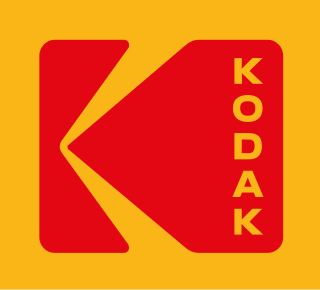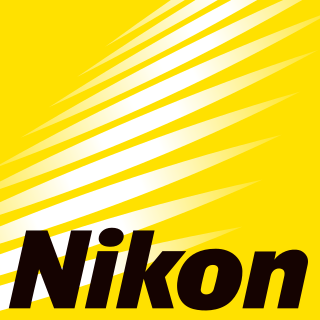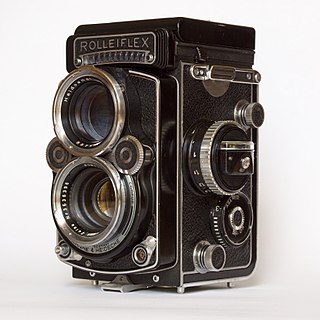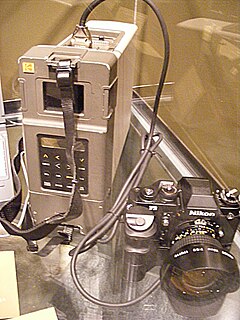
The Eastman Kodak Company is an American public company that produces various products related to its historic basis in analogue photography. The company is headquartered in Rochester, New York, and is incorporated in New Jersey. Kodak provides packaging, functional printing, graphic communications, and professional services for businesses around the world. Its main business segments are Print Systems, Enterprise Inkjet Systems, Micro 3D Printing and Packaging, Software and Solutions, and Consumer and Film. It is best known for photographic film products.

A rangefinder camera is a camera fitted with a rangefinder, typically a split-image rangefinder: a range-finding focusing mechanism allowing the photographer to measure the subject distance and take photographs that are in sharp focus. Most varieties of rangefinder show two images of the same subject, one of which moves when a calibrated wheel is turned; when the two images coincide and fuse into one, the distance can be read off the wheel. Older, non-coupled rangefinder cameras display the focusing distance and require the photographer to transfer the value to the lens focus ring; cameras without built-in rangefinders could have an external rangefinder fitted into the accessory shoe. Earlier cameras of this type had separate viewfinder and rangefinder windows; later the rangefinder was incorporated into the viewfinder. More modern designs have rangefinders coupled to the focusing mechanism so that the lens is focused correctly when the rangefinder images fuse; compare with the focusing screen in non-autofocus SLRs.

Leica Camera AG is a German company that manufactures cameras, optical lenses, photographic lenses, binoculars, rifle scopes and microscopes. The company was founded by Ernst Leitz in 1869, in Wetzlar, Germany.

Minox is a manufacturer of cameras, known especially for its subminiature camera.

Canon Inc. is a Japanese multinational corporation headquartered in Ōta, Tokyo, Japan, specializing in optical, imaging, and industrial products, such as lenses, cameras, medical equipment, scanners, printers, and semiconductor manufacturing equipment.

Konica Minolta, Inc. is a Japanese multinational technology company headquartered in Marunouchi, Chiyoda, Tokyo, with offices in 49 countries worldwide. The company manufactures business and industrial imaging products, including copiers, laser printers, multi-functional peripherals (MFPs) and digital print systems for the production printing market. Konica Minolta's Managed Print Service (MPS) is called Optimised Print Services. The company also makes optical devices, including lenses and LCD film; medical and graphic imaging products, such as X-ray image processing systems, colour proofing systems, and X-ray film; photometers, 3-D digitizers, and other sensing products; and textile printers. It once had camera and photo operations inherited from Konica and Minolta but they were sold in 2006 to Sony, with Sony's Alpha series being the successor SLR division brand.

Nikon Corporation, also known just as Nikon, is a Japanese multinational corporation headquartered in Tokyo, Japan, specializing in optics and imaging products. The companies held by Nikon form the Nikon Group.

Praktica was a brand of camera manufactured by Pentacon in Dresden in eastern Germany, within the GDR between 1949 and the German reunification in 1990. The firm Pentacon was divided in mainly two parts and sold after German reunification. Schneider Kreuznach and Noble bought parts of it. Pentacon is a Dresden-based company in the optical and precision engineering industry, which was at times a major manufacturer of photo cameras. The name Pentacon is derived on the one hand from the Contax brand of the Dresden Zeiss Ikon Kamerawerke and Pentagon, because a pentaprism for SLR cameras developed for the first time in Dresden has this shape in cross section. Today's PENTACON GmbH Foto- und Feinwerktechnik is still based in Dresden. It is part of the Schneider Group, Bad Kreuznach. Pentacon is the modern-day successor to Dresden camera firms such as Zeiss Ikon; for many years Dresden was the world's largest producer of cameras. Previous brands of the predecessor firms included Praktica, Exa, Pentacon, Zeiss Ikon, Contax, Ica, Ernemann, Exakta, Praktiflex, and many more.

Rollei was a German manufacturer of optical instruments founded in 1920 by Paul Franke and Reinhold Heidecke in Braunschweig, Lower Saxony, and maker of the Rolleiflex and Rolleicord series of cameras. Later products included specialty and nostalgic type films for the photo hobbyist market.

Rolleiflex is the name of a long-running and diverse line of high-end cameras originally made by the German company Franke & Heidecke, and later Rollei-Werke.

Panavision is an American motion picture equipment company founded in 1953 specializing in cameras and lenses, based in Woodland Hills, California. Formed by Robert Gottschalk as a small partnership to create anamorphic projection lenses during the widescreen boom in the 1950s, Panavision expanded its product lines to meet the demands of modern filmmakers. The company introduced its first products in 1954. Originally a provider of CinemaScope accessories, the company's line of anamorphic widescreen lenses soon became the industry leader. In 1972, Panavision helped revolutionize filmmaking with the lightweight Panaflex 35 mm movie camera. The company has introduced other cameras such as the Millennium XL (1999) and the digital video Genesis (2004).

The Kodak Professional Digital Camera System or DCS, later unofficially named DCS 100, was the first commercially available digital single-lens reflex (DSLR) camera. It was a customized camera back bearing the digital image sensor, mounted on a Nikon F3 body and released by Kodak in May 1991; the company had previously shown the camera at Photokina in 1990. Aimed at the photo journalism market in order to improve the speed with which photographs could be transmitted back to the studio or newsroom, the DCS had a resolution of 1.3 megapixels. The DCS 100 was publicly presented for the first time in Arles (France), at the Journées de l'Image Pro by Mr Ray H. DeMoulin, the worldwide President of the Eastman Kodak Company. 453 international journalists attended this presentation, which took place in the Palais des Congres of Arles.

The Argus C3 was a low-priced rangefinder camera mass-produced from 1939 to 1966 by Argus in Ann Arbor, Michigan, United States. The camera sold about 2 million units, making it one of the most popular cameras in history. Due to its shape, size, and weight, it is commonly referred to as "The Brick" by photographers. The most famous 20th-century photographer who used it was Tony Vaccaro, who employed this model during World War II.
Sherman Mills Fairchild was an American businessman and investor. He founded over 70 companies, including Fairchild Aircraft, Fairchild Industries, and Fairchild Camera and Instrument. Fairchild made significant contributions to the aviation industry and was inducted into the National Aviation Hall of Fame in 1979. His Fairchild Camera & Instrument Corporation, Semiconductor Division company played a defining role in the development of Silicon Valley. He held over 30 patents for products ranging from the silicon semiconductor to the 8-mm home sound motion-picture camera. Fairchild is also responsible for inventing the first synchronized camera shutter and flash as well as developing new technologies for aerial cameras that were later used on the Apollo Missions.

Argus was an American maker of cameras and photographic products, founded in 1936 in Ann Arbor, Michigan. Argus originated as a subsidiary of the International Radio Corporation (IRC), founded by Charles Verschoor. Its best-known product was the C3 rangefinder camera, which enjoyed a 27-year production run and became one of the top-selling cameras in history. The company's Model A was the first low-cost 35 mm camera in the United States. Sylvania acquired Argus in 1959 and sold it in 1969, by which time it had ceased camera production. More recently, the Argus brand has been reestablished and is used on a variety of inexpensive digital cameras made by Argus Camera Company, LLC., located in Inverness, Illinois.

The Revere Camera Company was started in 1920 by Samuel Briskin, who also started Wollensak Recorders and Opticals.

The Ann Arbor News is a newspaper serving Washtenaw and Livingston counties in Michigan. Published daily online through MLive.com, the paper also publishes print editions on Thursdays and Sundays.

Shanghai Seagull Camera Ltd is a Chinese camera maker located in Shanghai, China. Seagull is the oldest camera maker in China. The product line of Seagull includes TLR cameras, SLR cameras, folding cameras, CCD and SLR camera lenses, large-format cameras, film, night vision scopes, and angle viewfinders. Seagull's cameras usually use basic, time-tested mechanical designs that require no batteries. Seagull has made 21 million cameras since it was founded in 1958. Some Seagull cameras are distributed through the Lomography company.
The International Radio Corporation (IRC) was an American radio receiver manufacturing company based in Ann Arbor, Michigan. It was established in 1931 by Charles Albert Verschoor with financial backing from Ann Arbor mayor William E. Brown, Jr., and a group of local business leaders. IRC manufactured numerous different radios, many bearing the Kadette name, including the first mass-produced AC/DC radio, the first pocket radio, and the first clock radio. Due to the seasonal nature of radio sales, the company attempted to diversify its offerings with a product that would sell well during the summer, eventually settling on a camera that would become the Argus. In 1939, IRC sold its radio-manufacturing business to its former General Sales Manager, W. Keene Jackson, although his new Kadette Radio Corporation only survived for a year before it went defunct. After World War II, International Industries and its International Research division became wholly owned subsidiaries of Argus, Inc., after which point the International name ceased to exist.

Nikon Museum is a museum of Nikon products, located at Nikon headquarters in Shinagawa, Tokyo, Japan.




















